

Eagle (Middle-earth) In J.
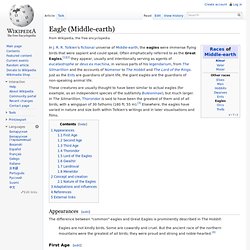
R. R. Tolkien's fictional universe of Middle-earth, the eagles were immense flying birds that were sapient and could speak. Ent. The Ents appear in The Lord of the Rings as ancient shepherds of the forest and allies of the free peoples of Middle-earth during the War of the Ring.
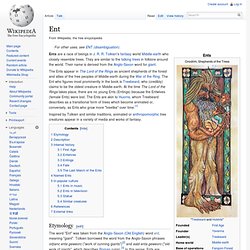
The Ent who figures most prominently in the book is Treebeard, who (credibly) claims to be the oldest creature in Middle-earth. At the time The Lord of the Rings takes place, there are no young Ents (Entings) because the Entwives (female Ents) were lost. The Ents are akin to Huorns, whom Treebeard describes as a transitional form of trees which become animated or, conversely, as Ents who grow more "treelike" over time.[1] Inspired by Tolkien and similar traditions, animated or anthropomorphic tree creatures appear in a variety of media and works of fantasy. Etymology[edit] Along with Old Norse jǫtunn (Jötunn), "ent" came from Common Germanic *etunaz. Description[edit] Treebeard, called by Gandalf the oldest living Ent and the oldest living thing that walks in Middle-earth,[4] is described as being around 14 feet (4 m) tall: First Age[edit]
Barrow-wight. They animated the dead bones of the Dúnedain buried there, as well as older bones of Edain from the First Age which still were buried there.
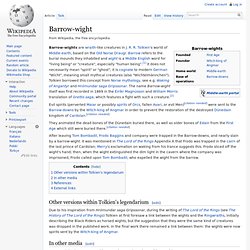
[citation needed] After leaving Tom Bombadil, Frodo Baggins and company were trapped in the Barrow-downs, and nearly slain by a barrow-wight. It was mentioned in The Lord of the Rings Appendix A that Frodo was trapped in the cairn of the last prince of Cardolan; Merry's exclamation on waking from his trance suggests this. Frodo sliced off the wight's hand; then, when the wight extinguished the dim light in the cavern where the company was imprisoned, Frodo called upon Tom Bombadil, who expelled the wight from the barrow.
Other versions within Tolkien's legendarium[edit] In other media[edit] Barrow-wights have appeared in several games based on Tolkien's writings: Barrow-wights appear in other media: References[edit] Dragon (Middle-earth) J.

R. R. Tolkien's Middle-earth legendarium features dragons closely based on those of European legend. Besides dragon (derived from French), Tolkien variously used the terms drake (the original English term, from Old English draca, in turn from Latin draco) and worm (from Old English wyrm, "serpent", "dragon").[1]
Smaug. Appearances[edit] The Hobbit[edit] Centuries spent sleeping atop his gold hoard caused gold and gemstones to become embedded in the flesh of Smaug's belly, augmenting the already essentially impenetrable armour of the scales that covered most of the rest of his body; however, when Bilbo observed him in his lair, he discovered a small bare patch on Smaug's left breast.
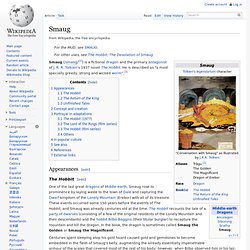
When Bilbo discussed this weakness of Smaug's with his dwarven companions, he was overheard by the thrush that roosted by the mountain's secret door. The thrush in turn told Bard the Bowman of Esgaroth. When Smaug attacked the town, Bard shot his Black Arrow into Smaug's weak spot, killing him. Dead Men of Dunharrow. Appearances[edit] Literature[edit] Their spirits haunted the caverns beneath the Dwimorberg, the Haunted Mountain, and the valley of Harrowdale that lay in its shadow—though they were said to appear in the valley only in times of trouble or death, haunting the hill of the Stone of Erech.

Malbeth the Seer prophesied that a day would come when need and haste would drive one of Isildur's heirs to take the Paths of the Dead and that the Dead would answer to his call. Thousands of years later, in the final years of the Third Age, that prophecy was fulfilled. In the War of the Ring, Aragorn, Isildur's heir and direct descendant, called upon the Dead, summoning them to the stone of Erech, and commanded them to fulfil their oath and be free. They followed him through Gondor's lands and fiefs south of the Mountains, and at the port of Pelargir they drove away the Corsairs of Umbar, allies of Sauron. Troll (Middle-earth) In J.
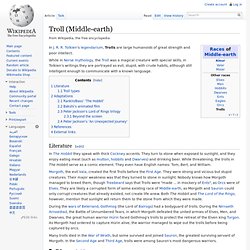
R. R. Tolkien's legendarium, Trolls are large humanoids of great strength and poor intellect. Sauron. Biography[edit] Before creation of the world[edit] The cosmological myth prefixed to The Silmarillion explains how the supreme being Eru initiated his creation by bringing into being innumerable spirits, "the offspring of his thought," who were with him before anything else had been made.
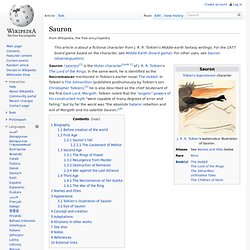
The being later known as Sauron thus originated as an "immortal (angelic) spirit. "[5] In his origin, Sauron therefore perceived the Creator directly. One Ring. An artist's unofficial impression of the One Ring Literature[edit] In The Lord of the Rings and the posthumously published The Silmarillion, Tolkien provides a detailed internal development from the forging of the Ring to its destruction.

In the fictional context of Middle-earth, these events take place during several thousand years in the Second and Third Age of Arda. Description[edit] Sauron intended it to be the most powerful of all Rings, able to rule and control those who wore the others. Creating the Ring simultaneously strengthened and weakened Sauron's power. War of the Ring. In the fictional high fantasy-world of J.

R. R. Witch-king of Angmar. The Witch-king of Angmar, also known as the Lord of the Nazgûl and the Black Captain, is a fictional character and a major antagonist in J. R. R. Tolkien's Middle-earth fantasy writings. The Letters of J. R. R. Tolkien. The Letters of J. R. R. The Children of Húrin. The Children of Húrin is an epic fantasy novel which forms the completion of a tale by J. R. R. Tolkien. He wrote the original version of the story in the late 1910s, revised it several times later, but did not complete it before his death in 1973. His son, Christopher Tolkien, edited the manuscripts to form a consistent narrative, and published it in 2007 as an independent work. Overview[edit] However, the Elves manage to stay his assault, and most of their realms remain unconquered; one of the most powerful of these is Doriath, ruled by Thingol. The Road Goes Ever On. The Road Goes Ever On is a song cycle that has been published as sheet music and as an audio recording. The music was written by Donald Swann, and the words are taken from poems in J.
R. R. The History of The Hobbit. The History of The Hobbit is a two-volume study of J. R. R. The Adventures of Tom Bombadil. Bilbo's Last Song. "Bilbo's Last Song" is a poem by J. Unfinished Tales. Unfinished Tales (full title Unfinished Tales of Númenor and Middle-earth) is a collection of stories and essays by J. Middle-earth peoples. Elf (Middle-earth) Noldor. Exiles (Middle-earth) In J. Sindar. Teleri. Ancient history[edit] Silvan Elves. Vanyar. The name Vanyar (singular Vanya) means "(the) Fair" in Quenya, referring to their golden hair (the original meaning of the word "Vanya" approximating as "light/pale"). They are sometimes known, particularly amongst themselves, by their original name Minyar, meaning "the First".
Avari (Middle-earth) Sundering of the Elves. Sindarin. Quenya. Elrond. Legolas. Rivendell. Man (Middle-earth) Esgaroth. Orc (Middle-earth) Dúnedain. Rangers of the North. Aragorn. Númenor. Gondor. Boromir. Minas Tirith. The Fellowship of the Ring. Minor places in Middle-earth. Hobbit. Bilbo Baggins. Frodo Baggins. Shire (Middle-earth) Peregrin Took. Samwise Gamgee. Dwarf (Middle-earth) Moria (Middle-earth) Balrog. Durin. Gimli (Middle-earth) Durin's folk. Thorin Oakenshield. Lonely Mountain. The Silmarillion. Wizard (Middle-earth) Gandalf. Saruman. Silmaril. Arda (Middle-earth) Timeline of Arda. History of Arda. First Age. Second Age. Third Age. Fourth Age. Of the Rings of Power and the Third Age. Middle-earth. Vala (Middle-earth) Ainur (Middle-earth)
Middle-earth cosmology. Akallabêth. Quenta Silmarillion. Valaquenta. Ainulindalë. Elder Days. The Hobbit. The Lord of the Rings. The Fellowship of the Ring. The Two Towers. The Return of the King. J. R. R. Tolkien. Middle-earth canon. Tolkien's legendarium. Tolkien research. Christopher Tolkien.